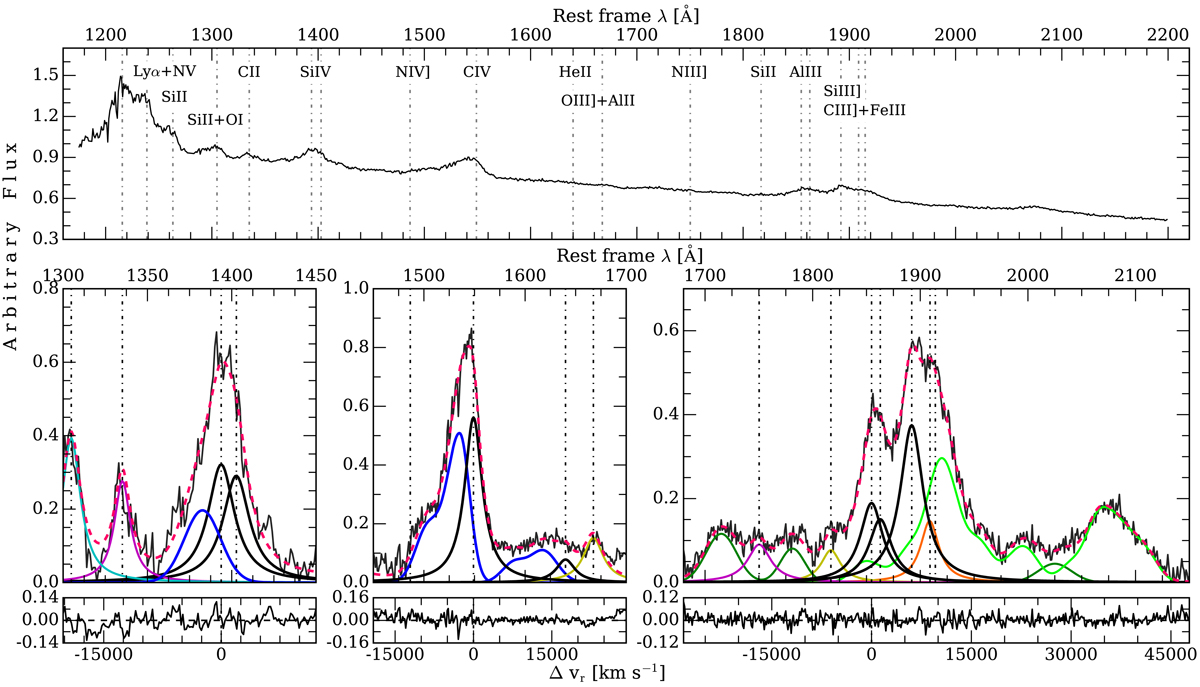Fig. 1.

Top panel: rest-frame composite spectrum (see Sect. 5.1). Abscissa corresponds to vacuum rest-frame wavelength in Å, while ordinate is in arbitrary intensity. Dot-dashed vertical lines identify the position at rest-frame of the strongest emission lines. Bottom panels: multicomponent fits after continuum subtraction for the 1400 Å blend, C IV![]() 1549 and 1900 Å blend spectral regions (Sect. 4.2). In all the panels continuous black line marks the broad component at rest-frame associated to Si IV
1549 and 1900 Å blend spectral regions (Sect. 4.2). In all the panels continuous black line marks the broad component at rest-frame associated to Si IV![]() 1397, C IV
1397, C IV![]() 1549, Al IIIλ1860 and Si III]
1549, Al IIIλ1860 and Si III]![]() 1892 respectively, while the blue one corresponds to the blueshifted component associated to each emission. Dashed pink line marks the fit to the whole spectrum. Dot-dashed vertical lines correspond to the rest-frame wavelength of each emission line. In the Si IV
1892 respectively, while the blue one corresponds to the blueshifted component associated to each emission. Dashed pink line marks the fit to the whole spectrum. Dot-dashed vertical lines correspond to the rest-frame wavelength of each emission line. In the Si IV![]() 1397 spectral range, the cyan line marks the contribution of O I
1397 spectral range, the cyan line marks the contribution of O I![]() 1304+Si II
1304+Si II![]() 1306 blend, while the magenta line corresponds to the C II
1306 blend, while the magenta line corresponds to the C II![]() 1335 emission line. In the C IV
1335 emission line. In the C IV![]() 1549 region, the yellow one corresponds to the O III
1549 region, the yellow one corresponds to the O III![]() 1663+Al II
1663+Al II![]() 1670 blend. In the 1900 Å blend range, Fe III and Fe II contributions are traced by dark and pale green lines respectively, magenta line marks the N III
1670 blend. In the 1900 Å blend range, Fe III and Fe II contributions are traced by dark and pale green lines respectively, magenta line marks the N III![]() 1750 and the yellow one corresponds to the Si II
1750 and the yellow one corresponds to the Si II![]() 1816. Lower panels correspond to the residuals, abscissa is in radial velocity units km s−1.
1816. Lower panels correspond to the residuals, abscissa is in radial velocity units km s−1.
Current usage metrics show cumulative count of Article Views (full-text article views including HTML views, PDF and ePub downloads, according to the available data) and Abstracts Views on Vision4Press platform.
Data correspond to usage on the plateform after 2015. The current usage metrics is available 48-96 hours after online publication and is updated daily on week days.
Initial download of the metrics may take a while.


